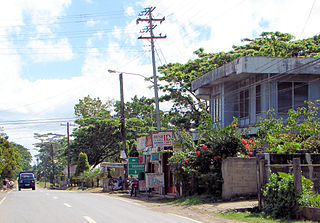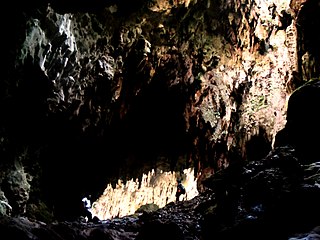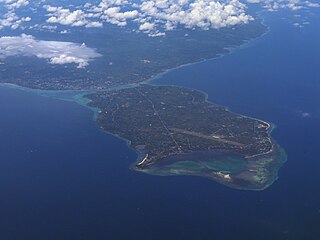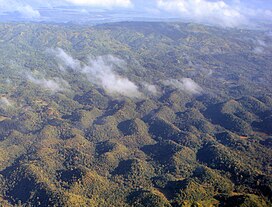
Bohol, officially the Province of Bohol, is an island province of the Philippines located in the Central Visayas region, consisting of the island itself and 75 minor surrounding islands. Its capital is Tagbilaran. With a land area of 4,821 km2 (1,861 sq mi) and a coastline 261 km (162 mi) long, Bohol is the tenth largest island of the Philippines.

The Philippine tarsier, known locally as mawumag in Cebuano and other Visayan languages, and magô in Waray, is a species of tarsier endemic to the Philippines. It is found in the southeastern part of the archipelago, particularly on the islands of Bohol, Samar and Leyte. It is a member of the approximately 45-million-year-old family Tarsiidae, whose name is derived from its elongated "tarsus" or ankle bone. Formerly a member of the genus Tarsius, it is now listed as the only member of the genus Carlito, a new genus named after the conservationist Carlito Pizarras.

Taal Lake, formerly known as Bombón Lake, is a freshwater caldera lake in the province of Batangas, on the island of Luzon in the Philippines. The lake fills Taal Volcano, a large volcanic caldera formed by very large eruptions between 500,000 and 100,000 years ago.

Batuan, officially the Municipality of Batuan, is a 5th class municipality in the province of Bohol, Philippines. According to the 2020 census, it has a population of 13,845 people.

Carmen, officially the Municipality of Carmen, is a 1st class municipality in the province of Bohol, Philippines. According to the 2020 census, it has a population of 49,191 people.

Clarin, officially the Municipality of Clarin, is a 5th class municipality in the province of Bohol, Philippines. According to the 2020 census, it has a population of 21,158 people.

Inabanga, officially the Municipality of Inabanga, is a 3rd class municipality in the province of Bohol, Philippines. According to the 2020 census, it has a population of 48,534 people.

Sagbayan, officially the Municipality of Sagbayan, is a 4th class municipality in the province of Bohol, Philippines. According to the 2020 census, it has a population of 24,335 people.

Tubigon, officially the Municipality of Tubigon, is a 1st class municipality in the province of Bohol, Philippines. According to the 2020 census, it has a population of 47,886 people.

Callao Cave is one of 300 limestone caves located in the Barangays of Magdalo and Quibal in the municipality of Peñablanca, about 24 km (15 mi) northeast of Tuguegarao City, the capital of Cagayan province within the Peñablanca Protected Landscape and Seascape in the western foothills of the Northern Sierra Madre Mountains on Luzon island in the Philippines. The town Peñablanca's name refers to the predominance of white limestone rock formations in the area. First excavated in 1980 by Maharlika Cuevas, the seven-chamber show cave is the best known natural tourist attraction of the Cagayan province and in February 2020 has officially been recognized as an important cultural property of the Philippines.

Panglao is an island in the north Bohol Sea, located in the Central Visayas region of the Visayas island group, in the south-central Philippines.

Mount Hibok-Hibok is a stratovolcano on Camiguin Island in the Philippines. It is one of the active volcanoes in the country and part of the Pacific ring of fire.

The Legazpi-Sikatuna Blood Compact or Sandugo was a blood compact, performed in the island of Bohol in the Philippines, between the Spanish explorer Miguel López de Legazpi and Datu Sikatuna, chieftain of Bohol, on March 16, 1565, to seal their friendship following tribal tradition. This is considered the first treaty of friendship between the Spaniards and Filipinos. "Sandugo" is a Visayan word which means "one blood".

Apo Reef is a coral reef system in the Philippines situated in the western waters of Occidental Mindoro province in the Mindoro Strait. Encompassing 34 square kilometres (13 sq mi), it is considered the world's second-largest contiguous coral reef system, and is the largest in the country. The reef and its surrounding waters are protected areas administered as the Apo Reef Natural Park (ARNP). It is one of the best known and most popular diving regions in the country, and is in the tentative list for UNESCO World Heritage Sites.

The 2013 Bohol earthquake occurred on October 15 at in Bohol, an island province located in Central Visayas, Philippines. The magnitude of the earthquake was recorded at 7.2, with epicenter 6 kilometres (3.7 mi) S 24° W of Sagbayan, and its depth of focus was 12 kilometres (7.5 mi). It affected the whole Central Visayas region, particularly Bohol and Cebu. The earthquake was felt in the whole Visayas area and as far as Masbate island in the north and Cotabato provinces in southern Mindanao.

The Rajah Sikatuna Protected Landscape is a protected landscape area of forested limestone hills, grasslands and natural springs in the island province of Bohol in the Central Visayas region of the Philippines. It is the largest remaining tract of natural forest in Bohol and one of the Philippines' top birdwatching sites. The park was initially gazetted a national park in 1987 covering approximately 9,023 hectares. In 2000, it was reestablished as a protected landscape under the National Integrated Protected Areas System covering its present area of 10,452.6 hectares. The park is one of the island's major tourist attractions located just south of the famous Chocolate Hills. It was named after the Bohol chieftain who entered into a blood-compact with Spanish conquistador Miguel López de Legazpi on the island in 1565.

The Samar Island Natural Park, in Samar, is the largest contiguous tract of old-growth forest in the Philippines. It is the country's largest terrestrial protected area, with an area of 333,300 hectares. The buffer is spread north to south over the island's three provinces and totals 458,700 hectares, about a third of the entire island of Samar.

Cabilao is a Philippine island in the Cebu Strait, part of Bohol Province. It is home to the only natural lake in the province: Cabilao Island Lake, also called Lake Danao or Lanao.

The Loay Interior Road is a 78.92-kilometer (49.04 mi), two lane national secondary road that connects the municipality of Loay to the municipality of Trinidad in Bohol, Philippines. This highway serves as one of the principal gateways to Carmen, which is known for being the main location and tourist spot of the Chocolate Hills.
Controversy arose when a resort built in the middle of the Chocolate Hills in Bohol in the Philippines came to wider public attention in March 2024. The geological formations are a protected area.


























